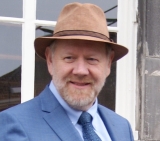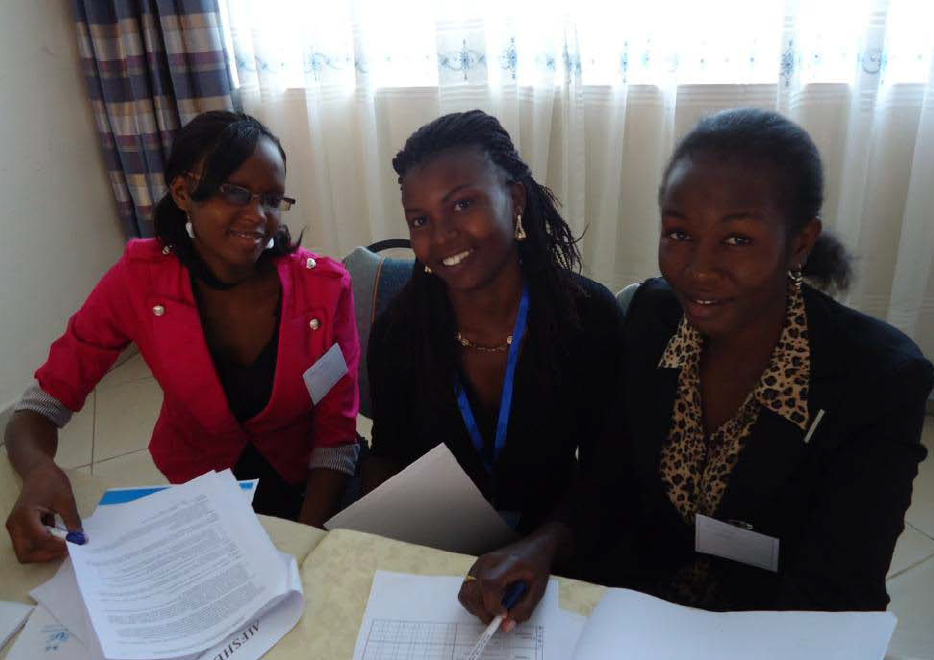AISHE: Assessment Instrument for Sustainability in Higher Education |
Wikipedia (Dutch): https://nl.wikipedia.org/wiki/AISHE.
Information about the various AISHE books is available here, including links to download most of them.
AISHE is an instrument for the design and implementation of ESD: Education for Sustainable Development.
AISHE is an assessment instrument, as its name indicates. At the same time, it is also a strategic tool for the development of an ESD policy: of a university, a college, a campus, a faculty, a school, an academy, an institute, or a separate education or research program.
Besides, it is a method to raise awareness and involvement in sustainable development with people: board members, managers, researchers, educators, other staff members, students.
Finally: together with the certification system based on AISHE, it is also a method to express appreciation or even admiration for the results that these people have achieved, often through hard and long work.
AISHE is one of the ESD assessment instruments that are recognized by the International Platform for Sustainability Performance in Education. In fact, is is the oldest such tool, having set a trend for others. You can find AISHE here on the Platform website.
Whereas other, comparable tools are applied mostly in the USA ('STARS', managed by AASHE); the UK and other Anglosaxon countries ('LiFE', managed by the EAUC); or France ('Plan Vert', the Green Plan);
AISHE was applied hundreds of times in ca. 30 countries: mainly in continental Europe, Africa, and Latin America.
For an overview, go here.
Information about the AISHE Manual, and how it can be downloaded, is available on the Book Pages of this website.
How it works; including videoclips (in Dutch)
AISHE as a fundamental system for all levels of Dutch education
AIFSHE, for developing countries
On the right: Students participating in an assessment at Kenyatta University, Kenya, Africa
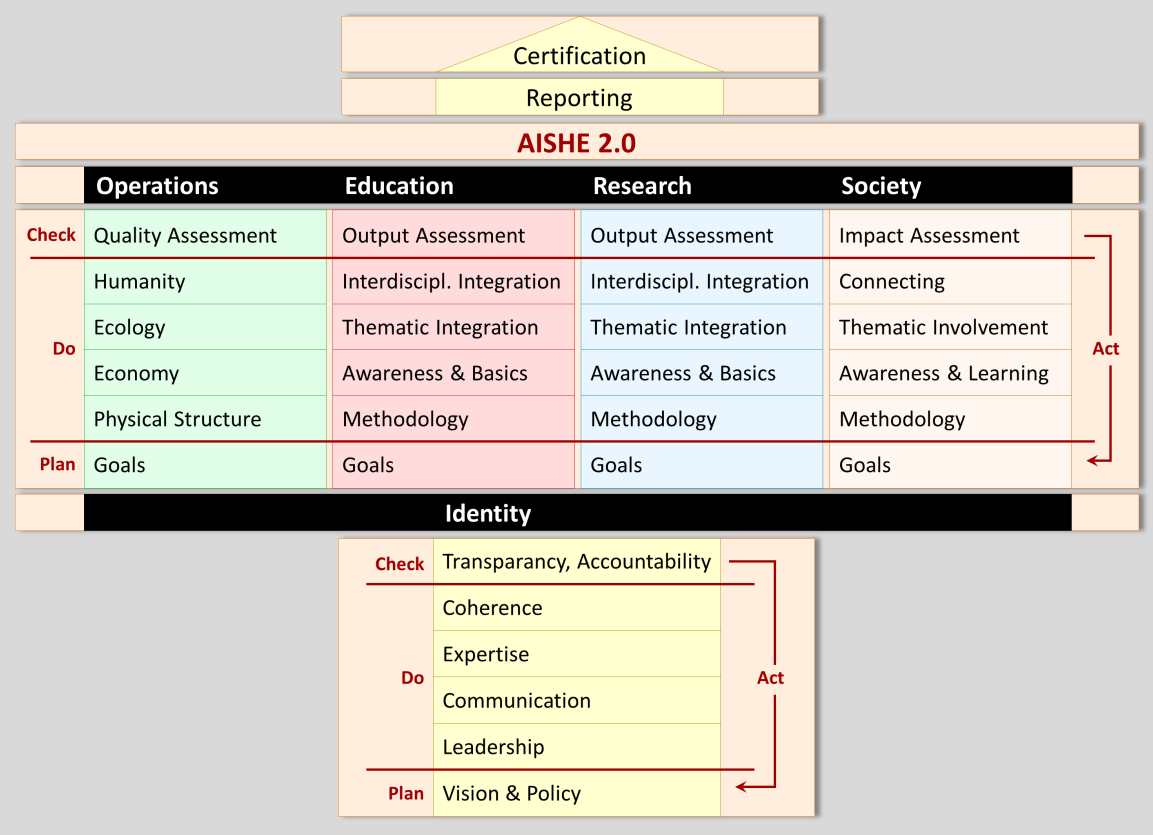
Two kinds of application
AISHE can be used in two ways: either as an internal tool, i.e. as an instrument for self-evaluation, or as an external tool, aiming at certification or benchmarking.
The use as an internal tool for self-evaluation and policy development is completely free. All necessary materials can be downloaded from the internet or applied directly online. If used in this way, the assessment procedures (described below) can be followed exactly, but it is also possible to redesign these procedures in any way the involved organization desires.
If, on the other hand, AISHE is used as an external instrument, the AISHE assessment is chaired by a certified external AISHE assessor, and the assessment procedures are obligatory. An international AISHE certification system is in preparation; when this system is fully working, the external assessment will lead to the awarding of the certificate - if the assessed institution or department meets the demands. This certificate is a star system, with levels varying from 1 till 5 stars.
Experiences with such a certificate, based on an older version of AISHE, have proved that the acquisition of an AISHE certificate is a strong incentive for ongoing organization development towards ESD.
What you get
AISHE is structured in a modular way.There are five modules, as the image above shows: Identity; Operations; Education; Research; and Society.
The university can choose which modules it wants to use for an assessment, and to which university departments it wishes to apply those modules.
When AISHE is applied, the university gets a number of deliverables:
- An assessment report, in which:
- A clear and realistic image of the present situation regarding sustainable development in the university or department. Depending on the selection of modules and departments, this means:
- the basic vision (on sustainable development) of the university or of a part of it;
- the education of one, several or all study programs;
- the research of one, several or all research programs or institutes;
- the operations of a department, a building, a campus, or the entire university;
- the direct societal role of the university. - A ditto description of the desired situation on an agreed later date (e.g. 1 or 2 years later), forming…
- … a basis for the formulation of a coherent policy on sustainable development.
- Support and enthusiasm for this policy from the assessment participants, who together form a representation of the management, the staff members, the students and the external stakeholders.
- A strong incentive for continuous improvement.
Before the assessment takes place, you will have to make a few preparations. If you make use of an external AISHE assessor, (s)he will assist you with this.
First the department(s) are selected that are to be assessed. This can be an educational department, e.g. a faculty, a school, an academy, a separate study program or a small group of programs. Instead, it can be one or more research institutes; or a campus; or a service department; etc. Depending on the kind of department(s), modules of AISHE are selected.
Next, a group of ca. 15 persons is composed. They will have to be present as a group during the assessment, which will take e.g. a half or a whole day, depending on the number of assessment modules they participate in.
Together, these persons will have to be representative of the investigated department(s). As an example: if a study program is assessed, the group will consist of members of the management; members of the teaching staff, together representing all or most of the disciplines in the curriculum; students from all or most of the course stages; recent alumni; and experienced professionals working within the professional field of the program.
Next, a date will be set; the assessment participants are invited; a room and the catering are arranged; name plates are made; the AISHE manual is distributed among the participants; in short, all practical preparations are made that are necessary to do the assessment.
What you don't have to do
You do not spend a considerable amount of time to write all kinds of reports, as a preparation for the assessment. You don't investigate courses, train groups, indoctrinate the students, or whatever. The entire assessment takes place when the group of participants meets. If only one or two modules are applied, each once, then the whole assessment takes place within one half day, at the end of which you have the assessment report and all the other deliverables mentioned above.
Yes: AISHE is lean and mean. Highly efficient!
How about money?
AISHE itself is fully free. Every university can simply download the AISHE Manual and start using it: i.e., plan and perform internal assessments and use the outcomes for strategy and policy development.
However: if you choose to have the assessments chaired by an experienced AISHE assessor, you will probably get results that have a higher validity and reliability. If you invite such an assessor, you will understand that (s)he will expect a fee for the activities. If you want to know more, you can contact Niko Roorda to discover which AISHE assessors are available.
The above is true for the current version of AISHE: AISHE 2.0. For the outdated version, AISHE 1.0, there are other conditions. For an explanation, see below.
About (sufficient) expertise
There is another kind of preparation that may be important. Whether this step is necessary, depends on the level of experience with SD and ESD of the participants. If this level is rather low, it may be wise to set up an activity, some time before the assessment, to explain and practice with the concept of SD and with ways to integrate SD into the education, the operations, the research, etc. If you don't do this, you may get in trouble during the assessment, due to all kinds of confusion and misunderstandings.
If you hire an external AISHE assessor, this ESD expert may also help you with this preliminary activity, which may e.g. take the form of a study day for the entire staff of a department.
As mentioned before, AISHE consists of five modules, as the image above shows: Identity; Operations; Education; Research; and Society.
Each of the modules consists of six criteria. They are arranged according to the well-known Plan-Do-Check-Act (PDCA) cyle or Deming Cycle, as the image shows. The total number of criteria thus is 5 x 6 = 30 criteria. However, during an assessment, those 30 criteria are never applied all at once, as during the preparations, the modules are selected the will be applied, based on the selection of the (types of) departments that will be investigated.
A five-point scale has been developed, describing five consecutive stages of organizational development a university (or a part of it) can be in. The five stages are: (1) Activity oriented; (2) Process oriented; (3) System oriented; (4) Chain oriented; and (5) Society oriented.
The stages are to be interpreted as cumulative, i.e. the assessed department is only to be judged as meeting the demands of a certain development stage (for a given criterion), if also the demands of all lower stages have been met (for that criterion).
For every of the 30 criteria, the five stages are expressed in words. Here is an example. The module 'Identity' contains criterion I-4, 'Expertise'. The general description of I-4 in the AISHE Manual is:
"The expertise available to the organization about sustainable development is kept up-to-date and is sufficient to enable to work actively on the integration and improvement of sustainable development in the vision and the activities of the organization.
Partly, this expertise is available within the organization staff. Besides, an external network is functioning in order to utilize the expertise available in the outside world."
The five stages of I-4, 'Expertise', are:
Stage 1, Activity oriented:
- Staff development in sustainability depends on individual initiatives.
- Individual staff members have contacts with the direct stakeholders and with centers of expertise, in order to enlarge their knowledge and experience about sustainability.
Stage 2, Process oriented:
- There is a staff development plan in sustainability. This plan is mainly short term related.
- For the execution of the plan, facilities are made available by the management.
- On a regular basis, the organization benefits from the expertise about sustainability that is present with the direct stakeholders.
Stage 3, System oriented:
- There is a systematic staff development plan related to sustainable development, aimed at a middle long term.
- The expertise of the direct stakeholders is used systematically for the realization of this plan.
- For this goal, the external network is maintained and expanded systematically.
Stage 4, Chain oriented:
- The regular contacts with the external network not only contribute to the expertise within the organization, but also to the expertise of the network partners.
Stage 5, Society oriented:
- The organization is or has an (inter)nationally recognized center of expertise concerning sustainable development.
- Characteristics of this center are terms like: excellent, innovative, pro-active, long-term future-oriented.
- Society and the process of sustainable development benefit clearly from this expertise.
On the day of an assessment,, the assessor and the group of participants join at the prepared location. The assessment consists of three steps:
- The assessor explains to the group what is going to happen. The goals and the procedures of the assessment are explained, as well as the philosophy and the structure of AISHE. This step will take approximately 30 minutes.
- The participants all receive a score form, and they decide individually - without consulting any others - in which stage the assessed department is at that very moment, for each of the selected criteria. This is called the 'present stage'. When all are ready - after 30 to 45 minutes for one or two modules - the results are gathered on one overview form, copied, and distributed to all participants.
- Now the main activity starts: the Consensus Meeting, which may take maybe 3 hours, depending on the number of modules that are selected. During this meeting, the assessor will take the group through all of the selected criteria, one by one. For each, the members of the group exchange their opinions, leading to a discussion that will end in a decision about the 'present stage', made by the group in consensus - i.e. never by voting. After the present stage has been decided, the assessor invites the group to discuss ways for improvement (regarding the criterion that is being discussed). When this discussion leads to consensus, also the 'desired stage' is decided; and the assessor will move to the next criterion.
The differences between all 'present stages' and 'future stages' together form a set of desired improvements for a next policy period. In order to get an overview of all of them, the Consensus Meeting ends with a brief comparison between all planned improvements, and the assessor will ask the group to select a few 'high priorities'.
During the Consensus Meeting, a secretary takes notes, following a detailed structure for AISHE reports. Thanks to this, a (draft) report is completed at the moment the assessment is completed. Afterwards, the secretary may want to edit the report a bit to make it final.
After the assessment(s): the strategy or policy plan for ESD
Actually, the conclusions of an assessment, nicely put down in the assessment report, are not decisions. Formally speaking, the proposed improvements have the status of recommendations to the management. Of course, the management actively took part in the assessment: if they did not, the assessment was invalid and useless. As the conclusions are all based on consensus, evidently the managers agree with them. However, a set of conclusions is not the same as a complete strategy or policy plan, and so: this is exactly what is still missing at the end of the assessment.
As a consequence, it is essential that you plan a management meeting: soon, very soon, after the assessment(s). If possible: the very next day. In this meeting, the conclusions of the assessment are used to formulate concrete plans, including everything a plan needs. Such as: measurable goals; deadlines; availability of means (e.g. time, finance, equipment); mandating responsibilities; procedures; reporting; etc. In short, the plan should be 'SMART'.
After the plan has been designed, decided and communicated, the real work starts, being done by everyone involved. These activities may be performed for, say, one or a couple of years, until a deadline has been reached. Then it starts all over again: new AISHE assessments are scheduled; groups of participants are composed; etc. Thus the cycle is closed. The cycle of continuous, neverending improvements. As you know it: perfection is never reached; things can always be made better.
Video example
Below, you can watch two videos of an AISHE assessment. They are in Dutch. The first, on the left, shows Niko Roorda as an assessor in the first step: explaining to the group what is going to happen.
In the second video, on the right side, a group of participants is discussing a series of criteria, deciding on 'present' and 'desired stages'.
Step 1 of an AISHE assessment: Step 3:
The assessor explains everything The Consensus Meeting
The first edition of AISHE, now called AISHE 1.0, was developed and scientifically validated by Niko Roorda in 2000 and 2001, at the end of which the instrument was published.
During the development project, a number of fundamental decisions had to be made. You can read about these decisions here.
On behalf of DHO, the Dutch Foundation for Sustainability in Higher Edication, a Certificate was based on AISHE, in Dutch: 'Keurmerk Duurzaam Hoger Onderwijs'. A system for consultancy and assessments was set up by Roorda, due to which nearly all universities, especially those for applied sciences, were assisted by ESD consultants from DHO with their ESD activities. Most of them acquired AISHE Certificates for several departments.
The need for AISHE 2.0
Around 2007 it became evident that serious improvements of the AISHE model were necessary. This conclusion was based on (1) an evaluation based on a large series of assessments since the end of 2001; (2) new insights in the international science of ESD; and (3) the fact that the academic world in general, and certainly ESD specifically, had become much more international, while AISHE was Dutch in its origins.
An international project, in which more than 20 universities in many European countries participated, was set up with the task to redesign AISHE. A small group of developers did the job, chaired by Roorda. This resulted in 'AISHE 2.0', with as its authors: Niko Roorda (Netherlands), Christian Rammel (Austria), Sylvia Waara (Sweden), and Urbano Fra Paleo (Spain). The old, outdated version was renamed 'AISHE 1.0'.
Comparison between AISHE 1.0 and AISHE 2.0
The main differences between AISHE 1.0 and AISHE 2.0 are:
- AISHE 1.0 focused on only one role of universities, i.e. the educational role. Other roles, such as the research, the operations and the relation with the community, did not get much attention. AISHE 2.0 has a much wider scope, as it dedicates explicit attention to all of those roles.
- AISHE 2.0, being related to all of those four roles, is more complicated than AISHE 1.0. In order to simplify the application, it is designed in a modular structure, which makes it possible to select only those modules in which a university is interested at a certain moment. This implies that the application of e.g. only the educational module is easier and less time-consuming than the use of AISHE 1.0.
- AISHE 1.0 was applicable only on the level of separate study programs, or of small groups of related study programs within a university. This was directly related to the educational focus of AISHE 1.0. As AISHE 2.0 also assesses other subjects, the application will vary. The operations are in many cases structured around an entire university, a campus or a building, and the application domain of the operations module varies accordingly. Research is often structured in research programs or institutes, and so they are the target of the research module.
- AISHE 1.0 was developed by a Dutch organization, DHO, and afterwards spread to other countries. AISHE 2.0 however was developed right from the start by an international development group in which about 15 different countries are represented.
During a global ESD meeting in Paris in 2012, AISHE 1.0 was explicitly considered as outdated, as it was too limited in its scope and its international and scientific basis. Instead, AISHE 2.0 was recognized during this meeting by the International Platform for Sustainability Performance in Education as one of its valid and significant ESD assessments instruments.
Nevertheless: if a university in the Netherlands still wants to apply AISHE 1.0: the method is used commercially by Hobéon, a Dutch consultancy company, which edits the method annually and manages the 'Keurmerk Duurzaam Hoger Onderwijs' with it.
Secondary vocational education ('MBO')
Hobéon also applies AISHE for secondary vocational education ('MBO') in the Netherlands (for the 'ROC's'), awarding them with the MBO sustainability network DMBO (Duurzaam Middelbaar Beroepsonderwijs). Thanks to this, ROC's have been awarded the Keurmerk Duurzaam Middelbaar Beroepsonderwijs.
Elementary education
For primary education, Gerben de Vries (Netwerk Duurzame Pabo; formerly also Marnix Academy) reformulated AISHE. The result was called AISHE-BAO.
AISHE as a fundamental system for all levels of Dutch education
In 2014, a motion was accepted by the Dutch Parliament (Motie Ouwehand), which urged the Dutch government to investigate the current state concerning education and sustainability in the Netherlands, and to provide plans to strengthen the ESD development.
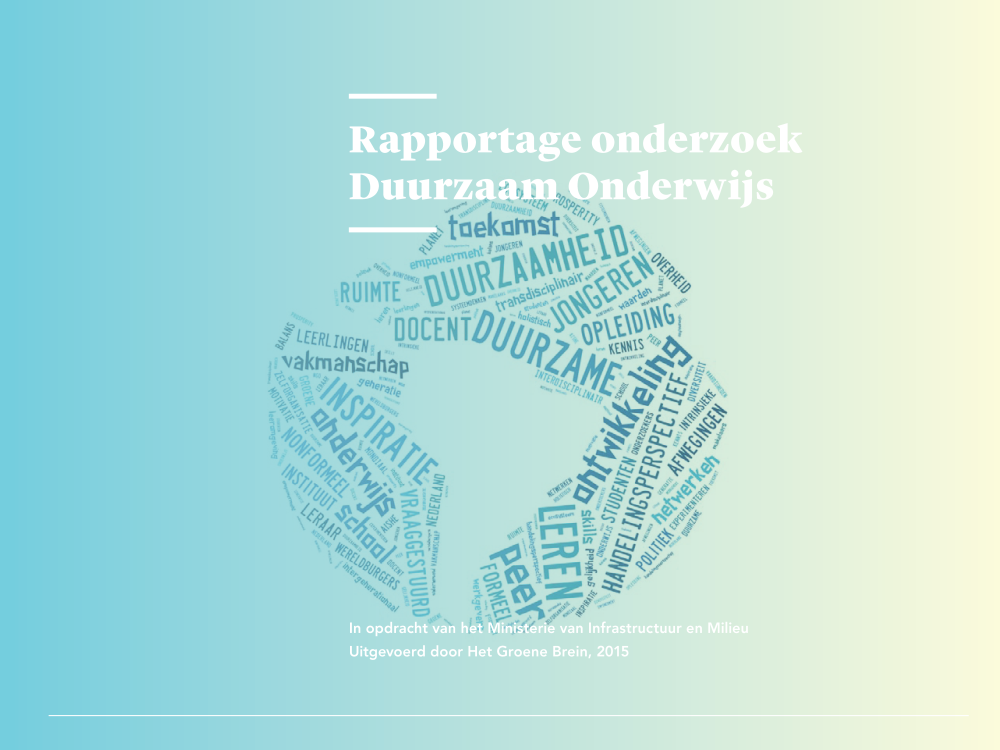 Consequently, following a request by the Dutch Ministry of Education, a report was produced by a think tank, Het Groene Brein, called Rapportage Onderzoek Duurzaam Onderwijs (Antoine Heideveld (ed.), 2015). In this report, a proposal was formulated to set up a system through which the ESD achievements can be compared of all Dutch educational institutions: at the primary, secondary and tertiary level. In other words: from elementary schools to universities. Several assessment and award systems for ESD exist for this range of institutions, such as the Eco Schools, the SustainaBul, and the above mentioned certificates (Keurmerken) for higher education and MBO (both by Hobéon).
Consequently, following a request by the Dutch Ministry of Education, a report was produced by a think tank, Het Groene Brein, called Rapportage Onderzoek Duurzaam Onderwijs (Antoine Heideveld (ed.), 2015). In this report, a proposal was formulated to set up a system through which the ESD achievements can be compared of all Dutch educational institutions: at the primary, secondary and tertiary level. In other words: from elementary schools to universities. Several assessment and award systems for ESD exist for this range of institutions, such as the Eco Schools, the SustainaBul, and the above mentioned certificates (Keurmerken) for higher education and MBO (both by Hobéon).
In order to combine all of these systems, the AISHE methodology and its 5 stages is now used as the underlying system for all of these assessment and certification methods.
As a result, a website has been set up by Toekomstbehendig: the 'Duurzame Onderwijsgids'. Here, many Dutch schools and universities can be found, including a description of their ESD achievements. For this purpose, the 5 stages of AISHE are called 'groeifasen' ('growth stages'), described as (1) 'zaadje' (seed); (2) 'kiem' (sprout); (3) 'plant'; (4) 'bloei' (blossom); and (5) 'vrucht' (fruit).
At present, even more companies apply AISHE. One of them is Constantis, a consultancy company for SD, which applies AISHE for its educational activities, together called TripppleEducation. (English link; Dutch link).
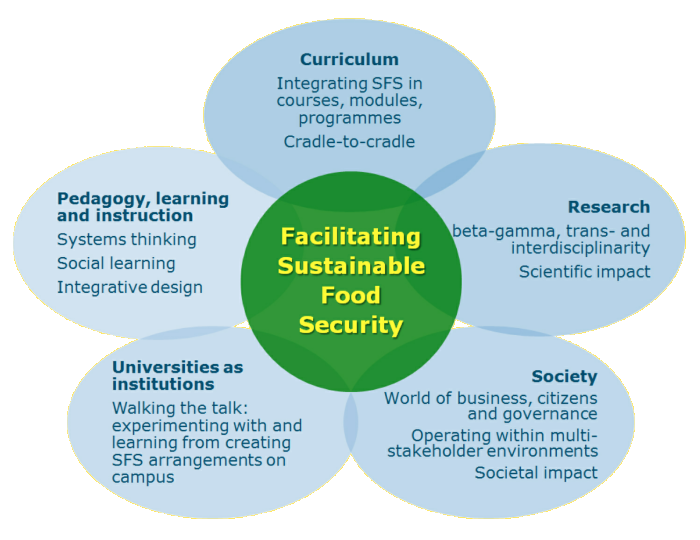 AIFSHE, for developing countries
AIFSHE, for developing countries
An adapted version of AISHE was created by an international group focusing on developing countries, mainly in Africa. As a part of the Comprehensive Africa Agriculture Development Programme (CAADP) program, set up by the African Union, AIFSHE was developed by a consortium in which Olivier Bello did most of the developing work, occasionally assisted by Niko Roorda. AIFSHE focuses on a quintessential aspect of SD in developing countries: sustainable food security; hence its name.
An AIFSHE website was launched. On its introduction page it says:
"In 2011, the Technical Centre for Agricultural and Rural Cooperation (CTA), began a collaboration with the Education and Competence Studies Group and the Centre for Sustainable Development & Food Security of Wageningen University and Research centre (CSD&FS, Wageningen UR), the African regional university networks (ANAFE, RUFORUM, TEAM Africa) and the Forum for Agricultural Research in Africa (FARA) to strengthen the engagement of tertiary agricultural education institutes (TAEs) in agricultural and rural development (ARD) policy processes."
The main ESD assessment instruments of the International Platform for Sustainability Performance in Education each have their own 'natural habitat'. For instance: 'STARS', managed by AASHE, is applied mostly in the USA. In the UK and other Anglosaxon countries, 'LiFE', managed by the EAUC, is the method; in France it is the 'Plan Vert'.
AISHE was applied mainly in continental Europe, in Africa, and in Latin America. On those continents, and occasionally in Asia, it has been used hundreds of times in more than 20 countries.
In Europe:
Universities and colleges in the Netherlands, Belgium, Spain, Italy, Germany, Austria, Sweden, Finland, Lithuania, Ukraine.
In Africa:
In Tanzania, Ghana, Kenya, Niger, Senegal, Burkina Faso, Benin, South Africa
In America:
In Brazil, Argentina, USA, Trinidad and Tobago
Elsewhere:
In Saudi Arabia, Bangladesh, Fiji, Samoa
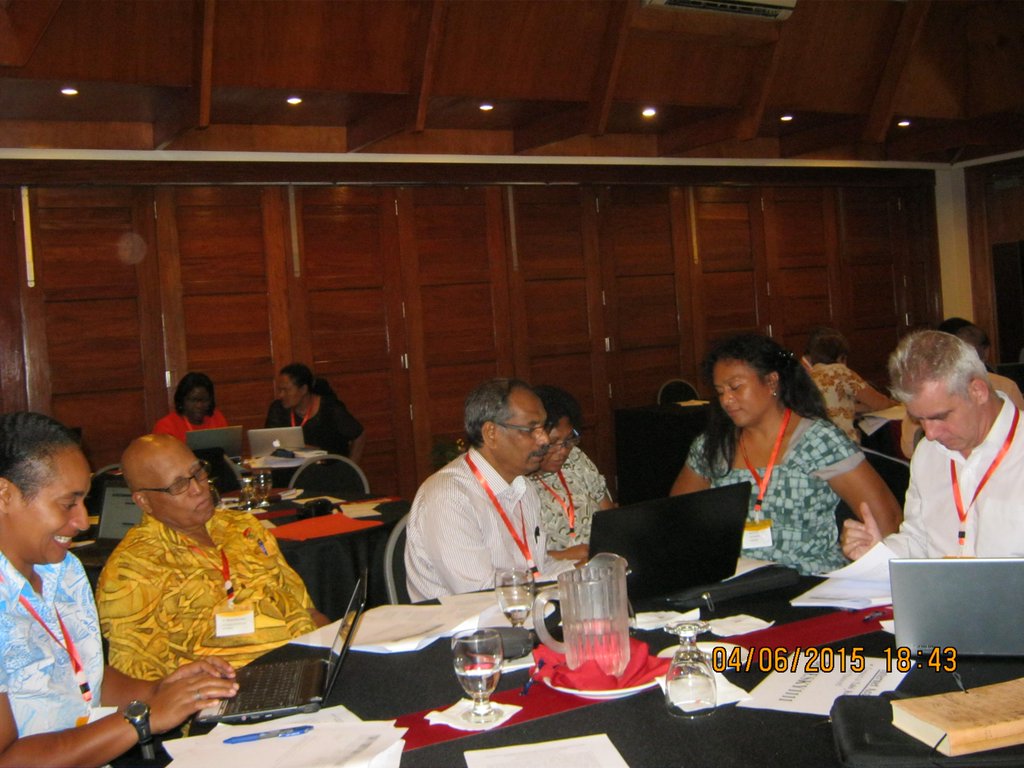
Assessment in the University of the South Pacific, Fiji
